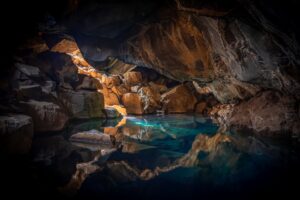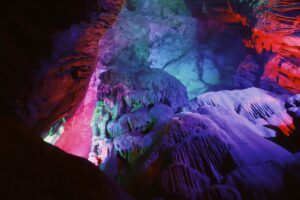Top 10 Largest Lakes in the United States
Top 10 Largest Lakes in the United States
WhiteClouds builds 3D Raised Relief Maps
Did you know we make
3D raised-relief maps
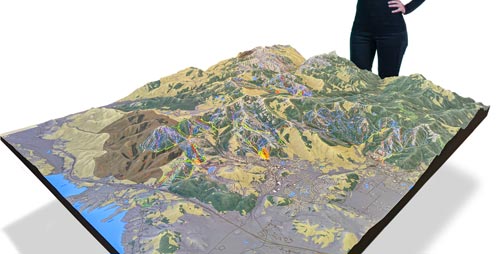
and
3D raised-relief maps
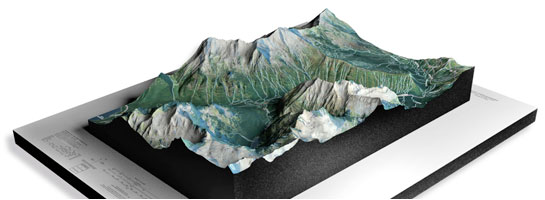
The United States is home to some of the largest and most spectacular lakes in the world, spanning from the icy tundras of Alaska to the sun-drenched beaches of Florida. These bodies of water are not only beautiful, but they also play a significant role in the culture, economy, and environment of the country. In this essay, we will explore the top 10 largest lakes in the United States by area, and discover what makes each one so special.
#1: Lake Superior (31,700 Square Miles)
Lake Superior is one of the largest and most iconic lakes in the world. It is located in North America, straddling the border between the United States and Canada. Known for its breathtaking beauty and rugged natural surroundings, this majestic lake has captured the hearts and imaginations of people for centuries.
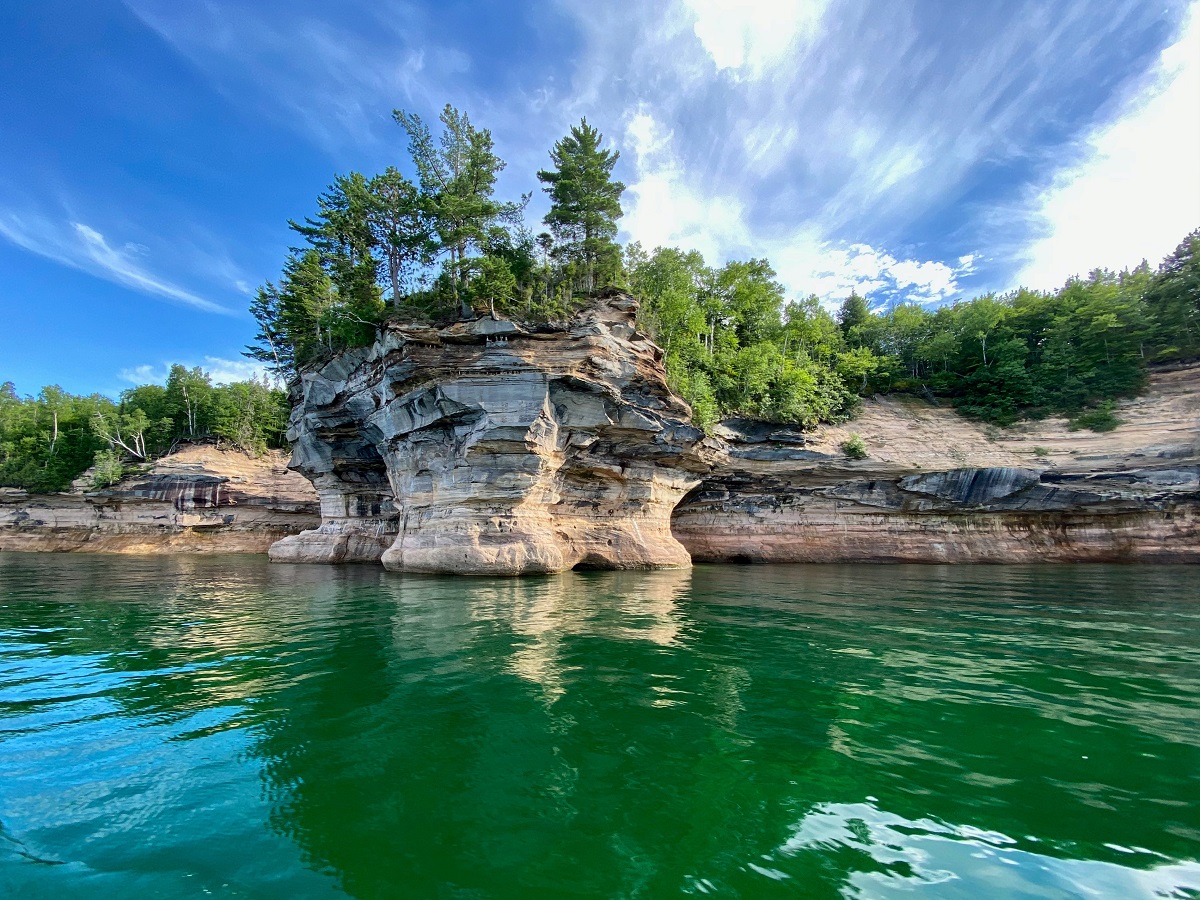
Location: Lake Superior is situated in the northern part of the continent, between the states of Minnesota, Wisconsin, and Michigan in the United States, and the provinces of Ontario and Quebec in Canada. The lake is connected to the Atlantic Ocean via the St. Lawrence River, and it is bordered by the rugged shoreline of the Canadian Shield to the north and the forests of the Upper Midwest to the south.
Surface Area: Lake Superior covers a total surface area of 31,700 square miles (82,100 square kilometers), making it the largest freshwater lake in the world by surface area. This massive body of water is larger than the entire country of Portugal, and it contains more water than all of the other Great Lakes combined.
Maximum Depth: The maximum depth of Lake Superior is 1,333 feet (406 meters), making it the deepest of the Great Lakes. This depth is roughly equivalent to the height of the Eiffel Tower in Paris, France. The lake’s average depth is around 483 feet (147 meters), which is also deeper than the other Great Lakes.
Volume: Lake Superior has a total volume of 2,900 cubic miles (12,100 cubic kilometers) of water, which is enough to fill all of the Great Lakes twice over. This immense volume of water is due in part to the lake’s large surface area and depth.
Interesting Facts about Lake Superior
Lake Superior is a fascinating and unique natural wonder, with many interesting facts and features. Here are just a few:
The lake is home to more than 80 species of fish, including the popular lake trout and salmon.
The lake’s water is extremely cold, with temperatures rarely exceeding 60 degrees Fahrenheit even in the summer months.
The lake’s rugged shoreline is home to countless species of birds and other wildlife, including bald eagles, loons, and black bears.
The lake is surrounded by numerous historic lighthouses, many of which are still in operation today.
The lake has been the site of numerous shipwrecks over the years, including the famous Edmund Fitzgerald in 1975.
Stories about Lake Superior
Lake Superior has been the setting for countless stories and legends over the years. From shipwrecks to ghost stories, the lake has captured the imaginations of people from all walks of life. One of the most famous stories is that of the Edmund Fitzgerald, a massive freighter that sank in a fierce storm on November 10, 1975, with the loss of all 29 crew members. The incident was immortalized in the hit song “The Wreck of the Edmund Fitzgerald” by Canadian singer-songwriter Gordon Lightfoot.
Industries on Lake Superior
Lake Superior is the largest of the Great Lakes and is located primarily in the United States and Canada. The region surrounding Lake Superior is home to a diverse range of industries, some of which are:
Mining: Lake Superior is home to significant deposits of iron ore, copper, nickel, and other minerals. The mining industry is an important source of employment and revenue for the region.
Shipping and Transportation: Lake Superior is a major transportation hub, with ports in Duluth-Superior, Thunder Bay, and other cities along the shore. These ports are important for shipping goods such as iron ore, coal, grain, and other commodities.
Forestry: The region surrounding Lake Superior is home to extensive forests of pine, spruce, fir, and other species. The forestry industry is an important source of wood products, such as lumber, paper, and pulp.
Tourism: Lake Superior is a popular destination for tourists, who come to enjoy the lake’s natural beauty, beaches, and recreational opportunities. The tourism industry is an important source of revenue for the region.
Fishing: Lake Superior is home to a variety of fish species, including lake trout, salmon, whitefish, and perch. The fishing industry in the region is an important source of employment and revenue.
History of Lake Superior
Lake Superior has a rich and complex history, dating back thousands of years. The lake was formed during the last ice age, when glaciers covered much of the continent. The indigenous peoples of the region, including the Ojibwe, Cree, and Chippewa, have lived along the lake’s shores for centuries, relying on its abundant fish and wildlife for sustenance. European explorers and fur traders arrived in the area in the 17th century, and the lake became an important center of trade and commerce in the region. Today, the lake remains an important part of the local economy, with fishing, tourism, and shipping all playing major roles.
Lake Superior is a truly remarkable natural wonder that has captured the hearts and imaginations of people for centuries. It is #1 on our Top 10 largest lakes. With its vast size, incredible depth, and rugged beauty, the lake is truly awe-inspiring. From the indigenous peoples who have lived along its shores for centuries to the European explorers and fur traders who first charted its waters, Lake Superior has played a vital role in the history and culture of the region. Today, the lake remains a vital part of the local economy, providing resources for fishing, tourism, and shipping. Whether you’re a nature lover, history buff, or just looking for a beautiful and unique destination to explore, Lake Superior is definitely worth a visit. Its natural beauty and fascinating history are sure to leave a lasting impression on anyone lucky enough to experience it.
#2: Lake Huron (23,000 square miles)
Lake Huron is one of the five Great Lakes of North America and is renowned for its breathtaking beauty, crystal-clear waters, and diverse marine life. It stretches across a vast area and has an interesting history that dates back thousands of years.
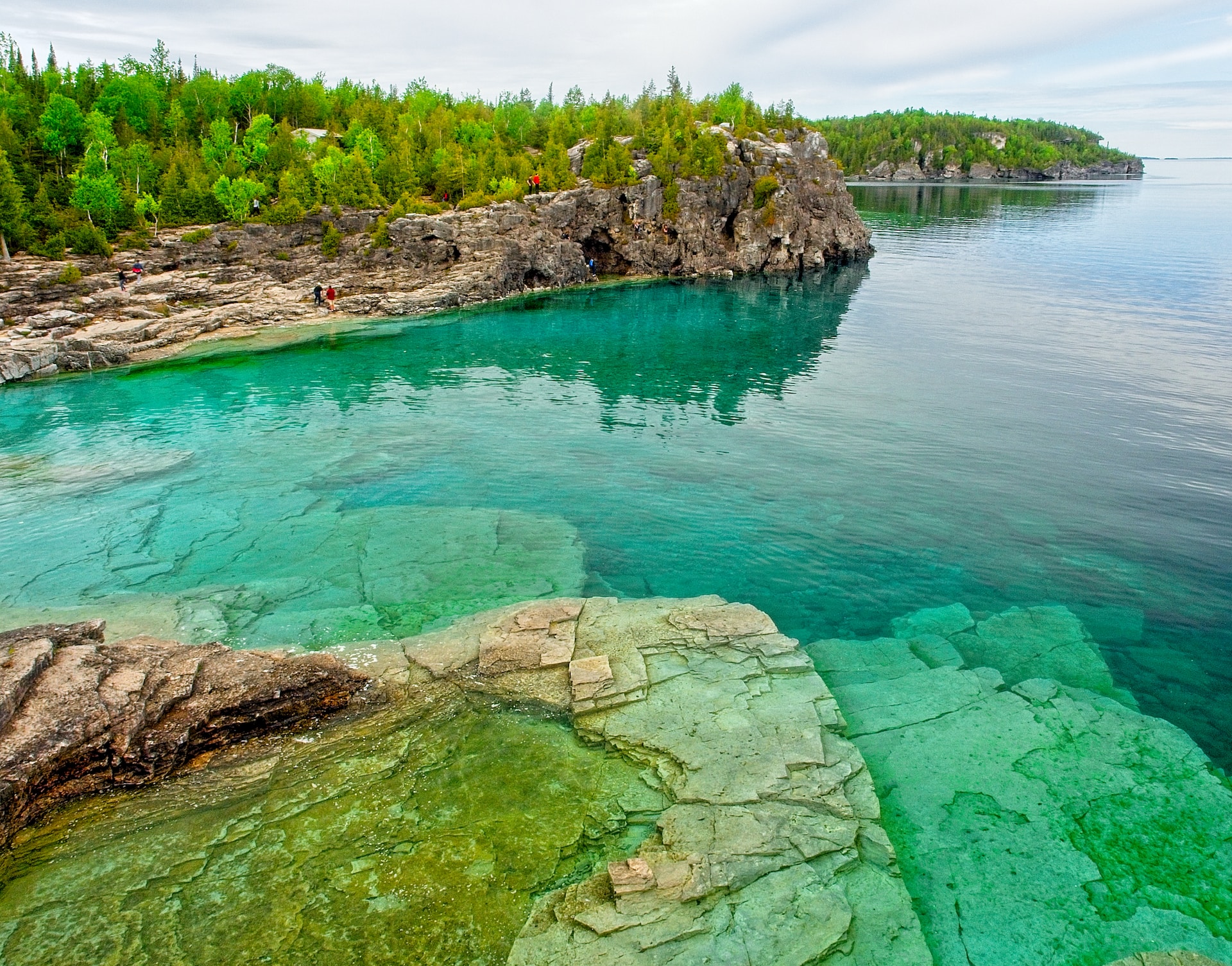
Location: Lake Huron is located in North America and spans across the Canadian province of Ontario and the U.S. state of Michigan. It is the second-largest of the Great Lakes. The lake is also connected to Lake Superior to the northwest via the St. Marys River, and to Lake Michigan to the south via the Straits of Mackinac.
Surface Area: Lake Huron has a surface area of approximately 23,000 square miles (59,600 square kilometers). It has a length of 206 miles (332 kilometers) from its northwest to southeast points and a width of 183 miles (295 kilometers) from its northeast to southwest points.
Maximum Depth: The maximum depth of Lake Huron is 750 feet (229 meters), making it the second deepest of the Great Lakes. The lake has an average depth of 195 feet (59 meters) and a shoreline that spans over 3,800 miles (6,100 kilometers).
Volume: Lake Huron has a volume of approximately 3,540 cubic miles (14,710 cubic kilometers). It has a water retention time of approximately 22 years, meaning that it takes approximately 22 years for the entire volume of water in the lake to be replaced.
Interesting Facts about Lake Huron
Lake Huron has many interesting facts that make it a unique and exciting destination to visit. For example, it is home to over 30,000 islands, making it the lake with the most islands in the world.
Stories about Lake Huron
Lake Huron has a rich history and many fascinating anecdotal stories. For instance, it is said that the lake was home to a legendary monster called “Nessie” by the locals. Although no evidence has ever been found of Nessie’s existence, many people believe that it still resides in the lake to this day.
Industries on Lake Huron
The region surrounding Lake Huron is home to a diverse range of industries, some of which are:
Shipping and Transportation: Lake Huron is a major transportation hub, with ports in cities such as Sarnia, Goderich, and Alpena. These ports are important for shipping goods such as grain, petroleum, and other commodities.
Tourism: Lake Huron is a popular destination for tourists, who come to enjoy the lake’s natural beauty, beaches, and recreational opportunities. The tourism industry is an important source of revenue for the region.
Fishing: Lake Huron is home to a variety of fish species, including walleye, lake trout, and yellow perch. The fishing industry in the region is an important source of employment and revenue.
Agriculture: The region surrounding Lake Huron is home to a significant amount of agricultural land, producing crops such as soybeans, corn, wheat, and potatoes. The agricultural industry is an important source of revenue for the region.
Manufacturing: The region surrounding Lake Huron is home to a number of manufacturing industries, including automotive, paper, and chemical manufacturing. These industries are important sources of employment and revenue for the region.
History of Lake Huron
Lake Huron has a long and fascinating history that dates back thousands of years. It was once home to many indigenous tribes who relied on the lake for their livelihoods. In the 1600s, French explorers arrived in the area, and the lake became an important trading route for fur traders. During the 1800s, the lake saw a surge in commercial shipping, which led to the establishment of many port towns and cities. Today, Lake Huron remains an important source of freshwater, tourism, and recreation.
Lake Huron is a breathtaking and fascinating destination that has something to offer everyone. It is #2 on our Top 10 largest lakes. Whether you’re interested in history, marine life, or simply looking for a beautiful place to relax, Lake Huron is a must-see destination. With its crystal-clear waters, diverse marine life, and rich history, it’s easy to see why it’s one of the most beloved lakes in North America.
#3: Lake Michigan (22,300 square miles)
Lake Michigan is one of the five Great Lakes of North America, located primarily in the United States. It is the third-largest lake of the Great Lakes by volume and the fifth-largest lake in the world. The lake has a rich history, natural beauty, and a unique ecosystem, making it a popular destination for tourists and a vital resource for the people who live in the region.
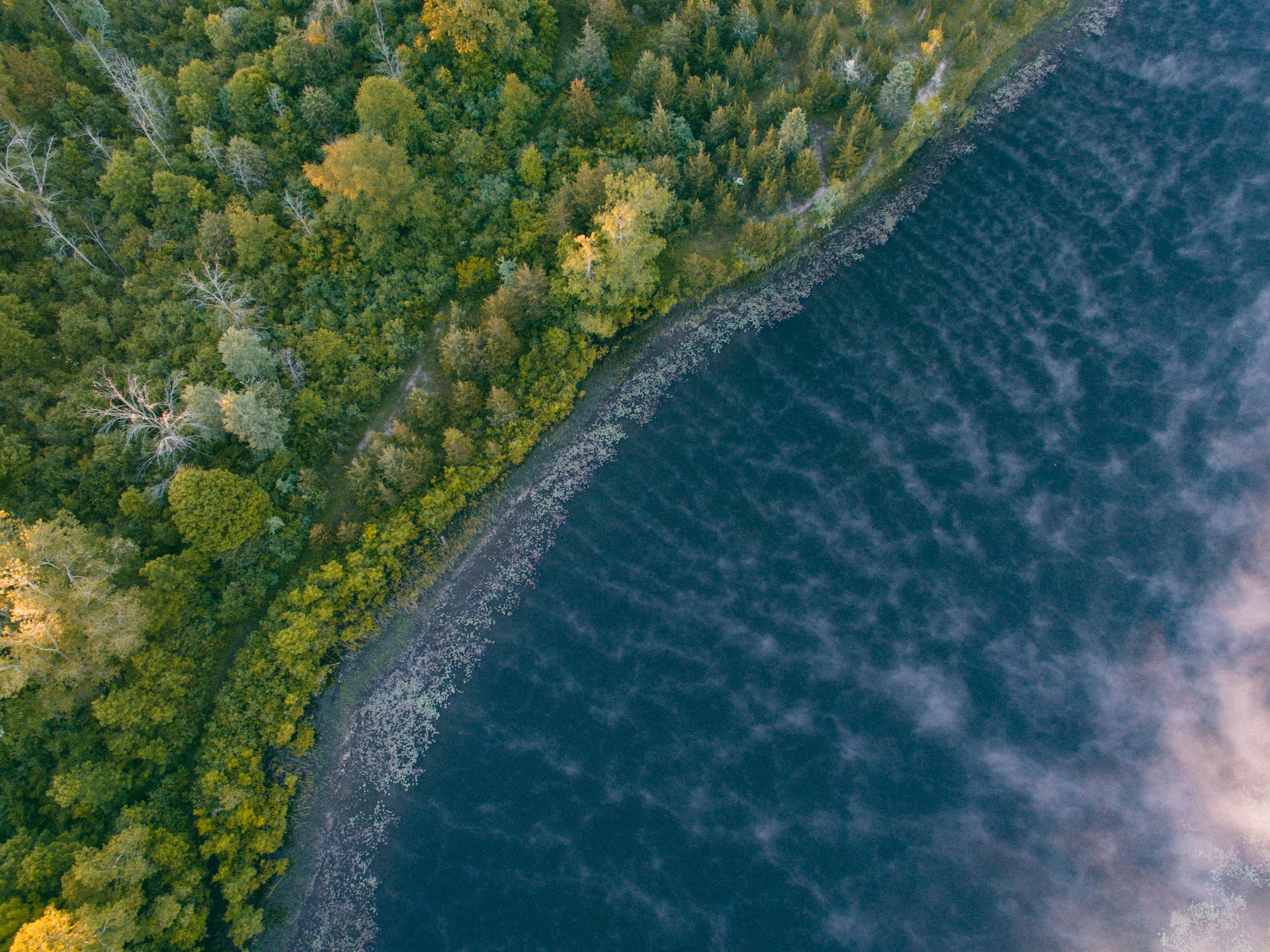
Location: Lake Michigan is located in the Midwest region of North America, bordered by the states of Michigan, Illinois, Wisconsin, and Indiana. It is the only one of the Great Lakes entirely within the United States. The lake’s western shore is known for its stunning sand dunes and pristine beaches, while the eastern shore is dotted with vibrant cities, including Chicago and Milwaukee.
Surface Area: Lake Michigan has a surface area of 22,404 square miles (58,016 square kilometers), making it the third-largest of the Great Lakes by surface area. The lake is roughly 307 miles long and 118 miles wide at its widest point.
Maximum Depth: The maximum depth of Lake Michigan is 925 feet (282 meters), making it the second-deepest of the Great Lakes, behind only Lake Superior. The average depth of the lake is 279 feet (85 meters).
Volume: Lake Michigan has a volume of 4,918 cubic miles (20,463 cubic kilometers), making it the third-largest of the Great Lakes by volume. The lake holds enough water to cover the entire state of New York to a depth of nearly 9 feet (2.7 meters).
Interesting Facts about Lake Michigan
Lake Michigan is the only Great Lake that is entirely within the borders of the United States.
The lake has more than 1,600 miles of shoreline.
Lake Michigan’s water level fluctuates over time, and the lake has been known to drop as much as 6 feet (1.8 meters) during periods of drought.
The lake’s name comes from the Ojibwe word mishigami, which means “large lake.”
The lake has a surface area that is larger than the entire country of Slovenia.
Stories about Lake Michigan
Lake Michigan is home to many unique and fascinating stories, from its role in the fur trade to its use during World War II.
Industries on Lake Michigan
Lake Michigan is the third-largest of the Great Lakes and is located entirely within the United States. The region surrounding Lake Michigan is home to a diverse range of industries, some of which are:
Shipping and Transportation: Lake Michigan is a major transportation hub, with ports in cities such as Chicago, Milwaukee, and Muskegon. These ports are important for shipping goods such as grain, petroleum, and other commodities.
Tourism: Lake Michigan is a popular destination for tourists, who come to enjoy the lake’s natural beauty, beaches, and recreational opportunities. The tourism industry is an important source of revenue for the region.
Manufacturing: The region surrounding Lake Michigan is home to a number of manufacturing industries, including automotive, steel, and chemical manufacturing. These industries are important sources of employment and revenue for the region.
Agriculture: The region surrounding Lake Michigan is home to a significant amount of agricultural land, producing crops such as corn, soybeans, and fruits such as cherries and apples. The agricultural industry is an important source of revenue for the region.
Fishing: Lake Michigan is home to a variety of fish species, including lake trout, salmon, and yellow perch. The fishing industry in the region is an important source of employment and revenue.
History of Lake Michigan
Lake Michigan has played a vital role in the history of North America, from the native peoples who called the region home to the French fur traders who established the first European settlements in the area. The lake played a critical role in transportation and commerce, with ships carrying goods between the various cities and towns that grew up along its shores. During World War II, the lake was also used as a training ground for the United States Navy, and the Great Lakes Naval Training Station was established on its shores.
Lake Michigan is a fascinating and important part of North America’s history and culture. It is #3 on our Top 10 largest lakes. It provides essential resources for the people who live in the region and offers a unique and beautiful natural environment for visitors to explore. From its size and depth to its interesting facts and anecdotal stories, Lake Michigan is a truly remarkable body of water that deserves our attention and respect.
#4: Lake Erie (9,910 square miles)
Lake Erie is one of the five Great Lakes of North America and is situated on the eastern border between the United States and Canada. It is a massive freshwater lake that spans across four states and one province, making it a popular destination for tourists and locals alike. Known for its stunning views, diverse wildlife, and abundance of recreational activities, Lake Erie is a true natural wonder that deserves our attention.
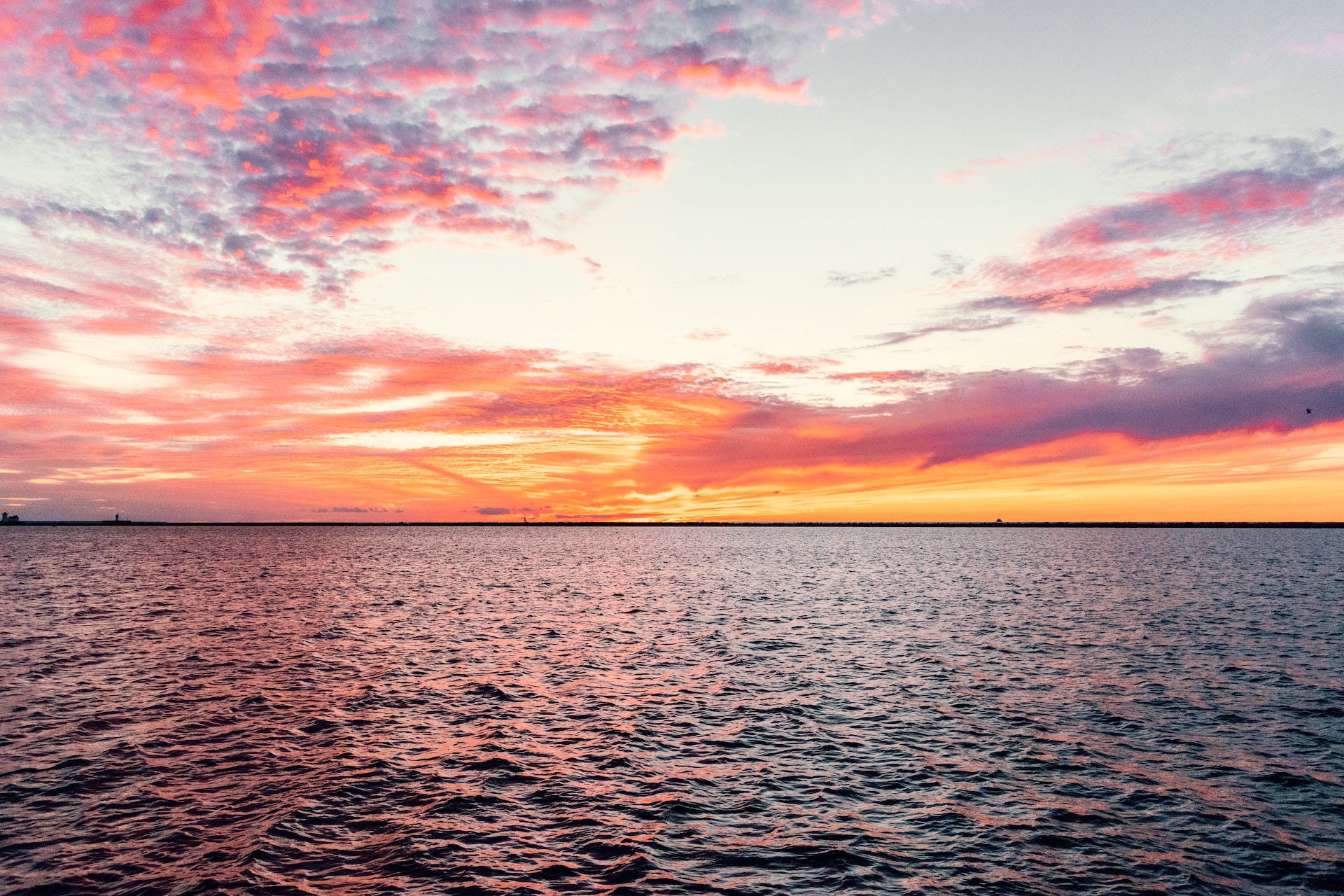
Location: Lake Erie is located on the eastern border of the United States and Canada. It is bordered by the Canadian province of Ontario to the north, the state of Michigan to the west, the state of Ohio to the south, and the state of Pennsylvania to the east. It is the fourth-largest of the Great Lakes by surface area and the smallest by volume.
Surface Area: Lake Erie has a surface area of 9,910 square miles (25,667 square kilometers), making it the fourth-largest of the Great Lakes. It has a length of 241 miles (388 kilometers) and a width of 57 miles (92 kilometers) at its widest point.
Maximum Depth: The maximum depth of Lake Erie is 210 feet (64 meters). It is the shallowest of the Great Lakes with an average depth of only 62 feet (19 meters).
Volume: Despite its relatively small size, Lake Erie still contains a massive volume of water. Its volume is estimated to be around 116 cubic miles (484 cubic kilometers), making it the smallest of the Great Lakes by volume.
Interesting facts about Lake Erie
Lake Erie is the warmest of the Great Lakes, with an average temperature of 62.6°F (17°C) during the summer months. It is home to over 120 species of fish, including walleye, yellow perch, and smallmouth bass.
The lake is known for its stunning sunsets, which are particularly beautiful from the shores of Ohio.
Lake Erie has over 50 islands, with the largest being Pelee Island, which is located in Canada.
The lake’s shoreline is dotted with numerous beaches, making it a popular destination for swimming, sunbathing, and water sports.
Stories about Lake Erie
Lake Erie has a rich history, and over the years, it has been the site of many interesting stories and legends. One such story involves the legendary Lake Erie Monster, also known as Bessie. According to legend, Bessie is a giant sea serpent that lurks beneath the waters of Lake Erie. There have been numerous sightings of the creature over the years, with some claiming to have seen it with their own eyes.
Industries on Lake Erie
The region surrounding Lake Erie is home to a diverse range of industries, some of which are:
Manufacturing: The region surrounding Lake Erie is home to a significant number of manufacturing industries, including automotive, steel, and chemical manufacturing. These industries are important sources of employment and revenue for the region.
Agriculture: The region surrounding Lake Erie is home to a significant amount of agricultural land, producing crops such as corn, soybeans, wheat, and grapes. The agricultural industry is an important source of revenue for the region.
Tourism: Lake Erie is a popular destination for tourists, who come to enjoy the lake’s natural beauty, beaches, and recreational opportunities. The tourism industry is an important source of revenue for the region.
Shipping and Transportation: Lake Erie is a major transportation hub, with ports in cities such as Toledo, Cleveland, and Erie. These ports are important for shipping goods such as grain, petroleum, and other commodities.
Fishing: Lake Erie is home to a variety of fish species, including walleye, perch, and bass. The fishing industry in the region is an important source of employment and revenue.
History of Lake Erie
Lake Erie has a rich history that dates back thousands of years. The lake was formed during the last ice age, around 10,000 years ago, when glaciers began to melt and retreat. The lake was once home to numerous Native American tribes, including the Erie, the Neutral, and the Seneca. In the late 17th century, European explorers began to explore the region, and in the 18th century, the lake became an important trade route for fur traders and other merchants. During the 19th century, the lake was home to numerous shipwrecks, and many of these wrecks have become popular dive sites for scuba divers.
Lake Erie is a true natural wonder that has captured the hearts and minds of people for generations. It is #4 on our Top 10 largest lakes. With its stunning views, diverse wildlife, and abundance of recreational activities, it is easy to see why so many people are drawn to this beautiful lake. Whether you are looking for a relaxing day at the beach, a thrilling water sports adventure, or a chance to explore the lake’s rich history, Lake Erie has something for everyone.
#5: Great Salt Lake (1,700 square miles)
Great Salt Lake, located in the northern part of the state of Utah in the United States, is a fascinating natural wonder that has captivated the minds of scientists, tourists, and locals for centuries. This massive body of water is shrouded in mystery and has a unique ecosystem that supports a diverse array of plant and animal life.
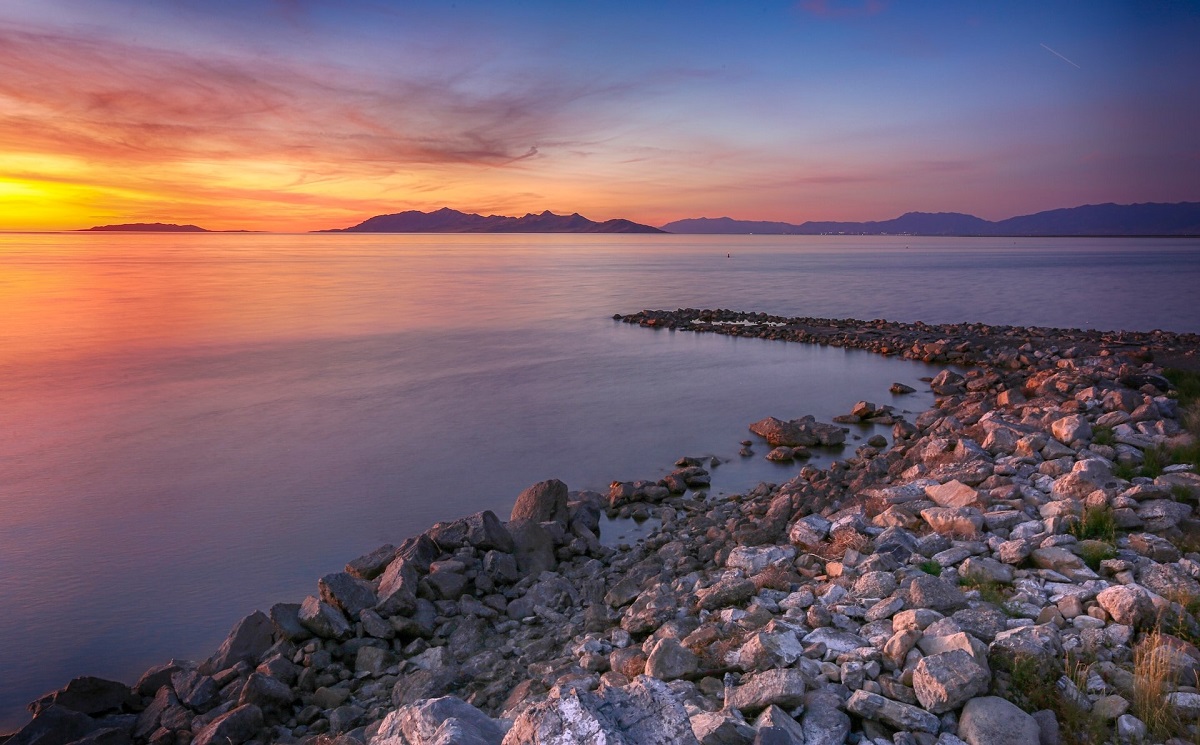
Location: Great Salt Lake is located in the Great Basin region of the western United States. The lake is situated in the northern part of the state of Utah and is bordered by the Wasatch Mountains to the east and the Great Salt Lake Desert to the west. The lake is easily accessible from the nearby city of Salt Lake City, which is only a short drive away.
Surface Area: Great Salt Lake is the largest saltwater lake in the Western Hemisphere and covers an area of approximately 1,700 square miles (4,400 square kilometers). The lake is also relatively shallow, with an average depth of only 14 feet (4.3 meters) and a maximum depth of 33 feet (10 meters).
Volume: Despite its relatively small depth, Great Salt Lake has a massive volume of approximately 4.5 cubic miles (18.8 cubic kilometers) of water. This enormous volume of water makes the lake an essential component of the region’s water cycle and plays a vital role in sustaining the local ecosystem.
Interesting Facts about Great Salt Lake
The Great Salt Lake is not only the largest saltwater lake in the Western Hemisphere but also the saltiest lake in the world outside of Antarctica. The lake’s salinity level is nearly eight times saltier than the ocean, making it incredibly challenging for most forms of life to survive. However, the lake is still home to a diverse range of animal and plant life, including brine shrimp and algae.
Stories about Great Salt Lake
One of the most famous anecdotes about Great Salt Lake involves a group of early pioneers who attempted to cross the lake in a wagon. The pioneers, who were unaware of the lake’s treacherous conditions, became stuck in the lake’s thick mud and were forced to abandon their wagon and continue on foot. Another anecdote involves a group of soldiers stationed near the lake during World War II, who used the lake’s salty water to clean their weapons, causing the guns to rust quickly.
Industries on Great Salt Lake
The Great Salt Lake, located in the U.S. state of Utah, is an important natural feature of the region. However, due to its unique chemical composition, there are relatively few industries that have been developed around the lake.
The most significant industry on the Great Salt Lake is the harvesting of salt. The lake is one of the largest sources of salt in the world, and several companies operate salt evaporation ponds on the lake’s shores to extract the mineral. The harvested salt is used in a variety of industries, including food processing, chemical manufacturing, and water softening.
In addition to salt production, there are some recreational industries around the Great Salt Lake. The lake is a popular destination for swimming, boating, and birdwatching, and there are several marinas and state parks around its shores.
Finally, there is some research and education industry around the Great Salt Lake, as scientists and educators study the lake’s unique ecosystem and geology. Universities and research institutions in the region use the lake as a site for field research and monitoring.
History of Great Salt Lake
The Great Salt Lake has a rich history dating back thousands of years. The lake was a vital resource for Native American tribes who lived in the area, who used the lake’s water and resources for food, medicine, and other essential purposes. The lake was later discovered by European explorers, who named it after its high salt content. The lake played an essential role in the region’s economy during the 19th century when it was used to transport goods by boat. Today, the lake remains an important cultural and ecological resource for the region.
The Great Salt Lake is a natural wonder that has fascinated scientists and tourists alike for centuries. It is #5 on our Top 10 largest lakes. Its unique ecosystem and high salt content make it an ideal destination for anyone interested in learning more about the natural world. Whether you are a history buff, an outdoor enthusiast, or a curious traveler, Great Salt Lake is a must-visit destination that is sure to leave you captivated and inspired.
#6: Lake of the Woods (1,660 square miles)
The Lake of the Woods is one of the most remarkable and breathtaking lakes in North America. This vast and pristine body of water is located on the border between the United States and Canada, and it offers an exceptional experience to all those who visit it.
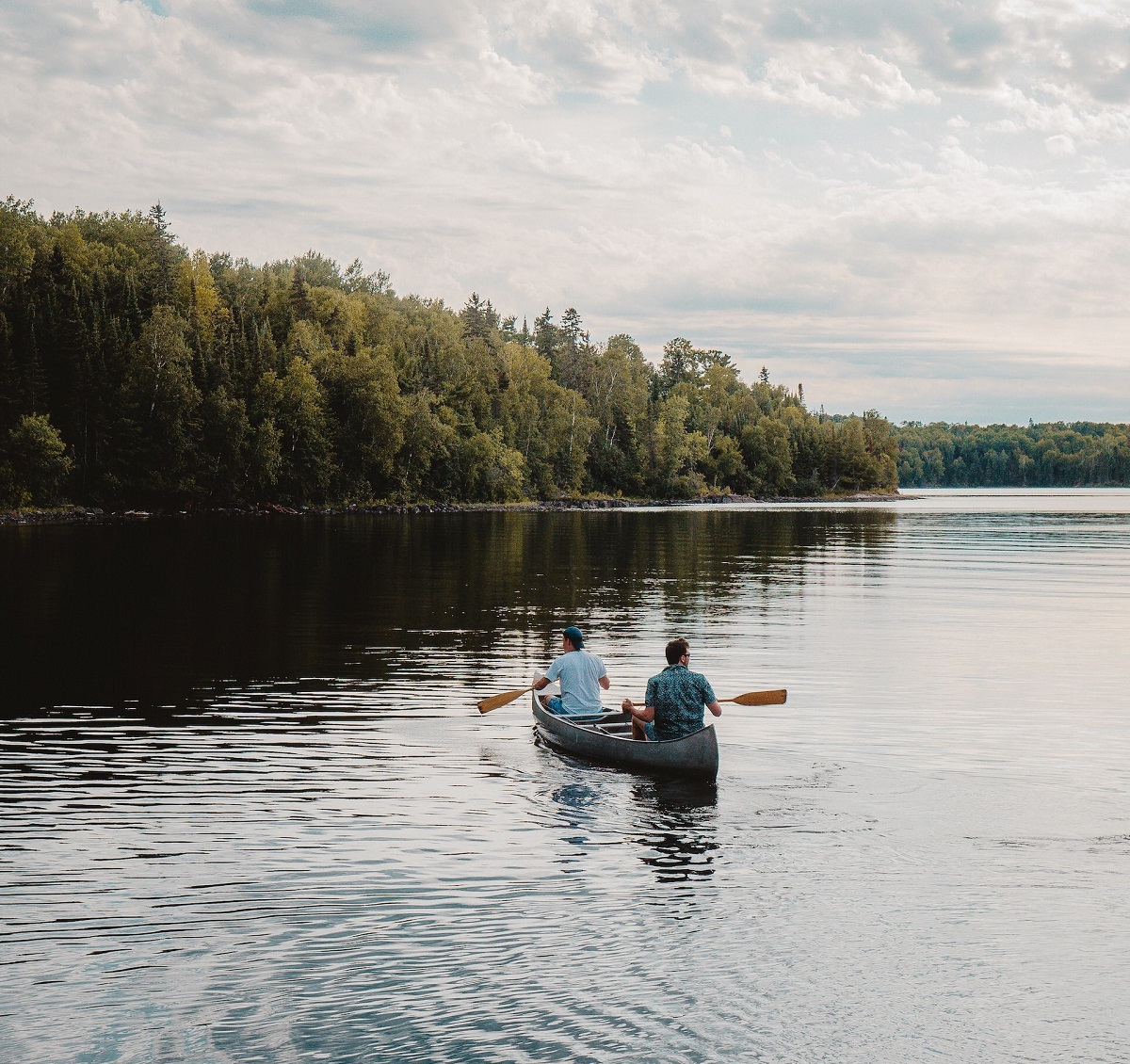
Location: The Lake of the Woods is situated on the border between the Canadian province of Ontario and the US state of Minnesota. This lake is part of the larger Lake of the Woods County, which encompasses a total area of 4,138 square miles. The lake’s shoreline stretches for over 25,000 miles or 40,000 kilometers, making it one of the largest freshwater lakes in North America.
Surface Area: The Lake of the Woods covers an area of 1,679 square miles or 4,347 square kilometers. It has a maximum length of 70 miles or 110 kilometers and a maximum width of 60 miles or 97 kilometers. The lake’s shoreline is dotted with over 14,500 islands, providing visitors with plenty of opportunities for exploring and adventure. This vast surface area is also home to an incredible diversity of fish species, including walleye, muskie, northern pike, and smallmouth bass.
Maximum Depth: The Lake of the Woods has a maximum depth of 210 feet or 64 meters, making it one of the deepest lakes in North America. This depth allows for an impressive array of underwater caves, crevices, and rock formations to explore. Divers and snorkelers flock to the lake to experience the stunning underwater scenery and observe the diverse aquatic life.
Volume: The volume of the Lake of the Woods is estimated to be approximately 49 cubic miles or 205 cubic kilometers. This massive volume of water makes it the 25th largest freshwater lake in the world. The lake’s vastness creates a sense of majesty and awe in all those who visit it.
Interesting Facts about Lake of the Woods
The Lake of the Woods is a remarkable body of water that is full of fascinating facts and features. Here are some interesting tidbits about this impressive lake:
The lake is home to over 65,000 miles or 100,000 kilometers of shoreline, making it the lake with the longest shoreline in the world.
The lake’s water is so clear that you can see up to 25 feet or 7.6 meters below the surface.
The lake is famous for its abundance of fish, including walleye, muskie, northern pike, and smallmouth bass.
The lake has over 14,500 islands, which are home to an array of wildlife, including bears, deer, and bald eagles.
The Lake of the Woods was once home to the Ojibwe tribe, who used the lake for transportation and fishing.
Stories about Lake of the Woods
The Lake of the Woods is a lake that has been the source of many stories and legends. One of the most famous is the tale of the lake monster, affectionately known as “Lakey.” This creature is said to inhabit the deep waters of the lake and is rumored to be over 30 feet or 9 meters long. Another story tells of a group of fishermen who, while out on the lake, saw a ghostly apparition of a woman walking on the water’s surface. The woman vanished before their eyes, leaving the fishermen bewildered and amazed.
Industries on Lake of the Woods
Lake of the Woods is a large freshwater lake located in the northern part of North America, bordering the Canadian provinces of Ontario and Manitoba, as well as the U.S. state of Minnesota. The region surrounding the lake is relatively rural, and the primary industries in the area include:
Fishing: Lake of the Woods is home to a variety of fish species, including walleye, northern pike, and lake trout. The fishing industry in the region is an important source of employment and revenue.
Forestry: The region surrounding Lake of the Woods is home to extensive forests, which are harvested for lumber and other wood products. The forestry industry is an important source of employment and revenue.
Tourism: Lake of the Woods is a popular destination for tourists, who come to enjoy the lake’s natural beauty, recreational opportunities, and the region’s hunting and fishing. The tourism industry is an important source of revenue for the region.
Mining: The region surrounding Lake of the Woods is home to significant mineral deposits, including gold, silver, and copper. Mining is an important industry in the area, providing employment and revenue.
Agriculture: The region surrounding Lake of the Woods is home to a significant amount of agricultural land, producing crops such as wheat, canola, and hay. The agricultural industry is an important source of revenue for the region.
History of Lake of the Woods
The history of the Lake of the Woods is as rich and varied as the lake itself. The region has been inhabited by various indigenous tribes for thousands of years, who relied on the lake for transportation, food, and water. The Ojibwe tribe, in particular, has a deep connection to the lake and still considers it to be a sacred site.
In the 18th and 19th centuries, the Lake of the Woods became an important location for the fur trade, with French and British traders establishing posts in the area. The region was also a key location for the development of the Canadian and American economies, with logging, mining, and fishing becoming major industries in the area.
Today, the Lake of the Woods is a popular destination for tourists and outdoor enthusiasts, who come to enjoy the lake’s natural beauty and abundant recreational opportunities.
The Lake of the Woods is truly a remarkable and awe-inspiring body of water. It is #6 on our Top 10 largest lakes. With its vast surface area, incredible depth, and rich history, it offers visitors a truly unique and unforgettable experience. Whether you’re interested in fishing, boating, or simply enjoying the stunning scenery, the Lake of the Woods has something for everyone. It’s no wonder that this lake has captured the imaginations of so many people over the years and continues to be a beloved destination for travelers from around the world.
#7: Iliamna Lake (1,150 square miles)
Nestled in the heart of Alaska’s wilderness lies a stunning body of water known as Iliamna Lake. This lake is not only one of the largest in the state but also one of the most pristine and awe-inspiring. With its vast expanse of crystal-clear water and surrounding snow-capped mountains, it is no wonder that Iliamna Lake has become a popular destination for tourists and adventurers alike.
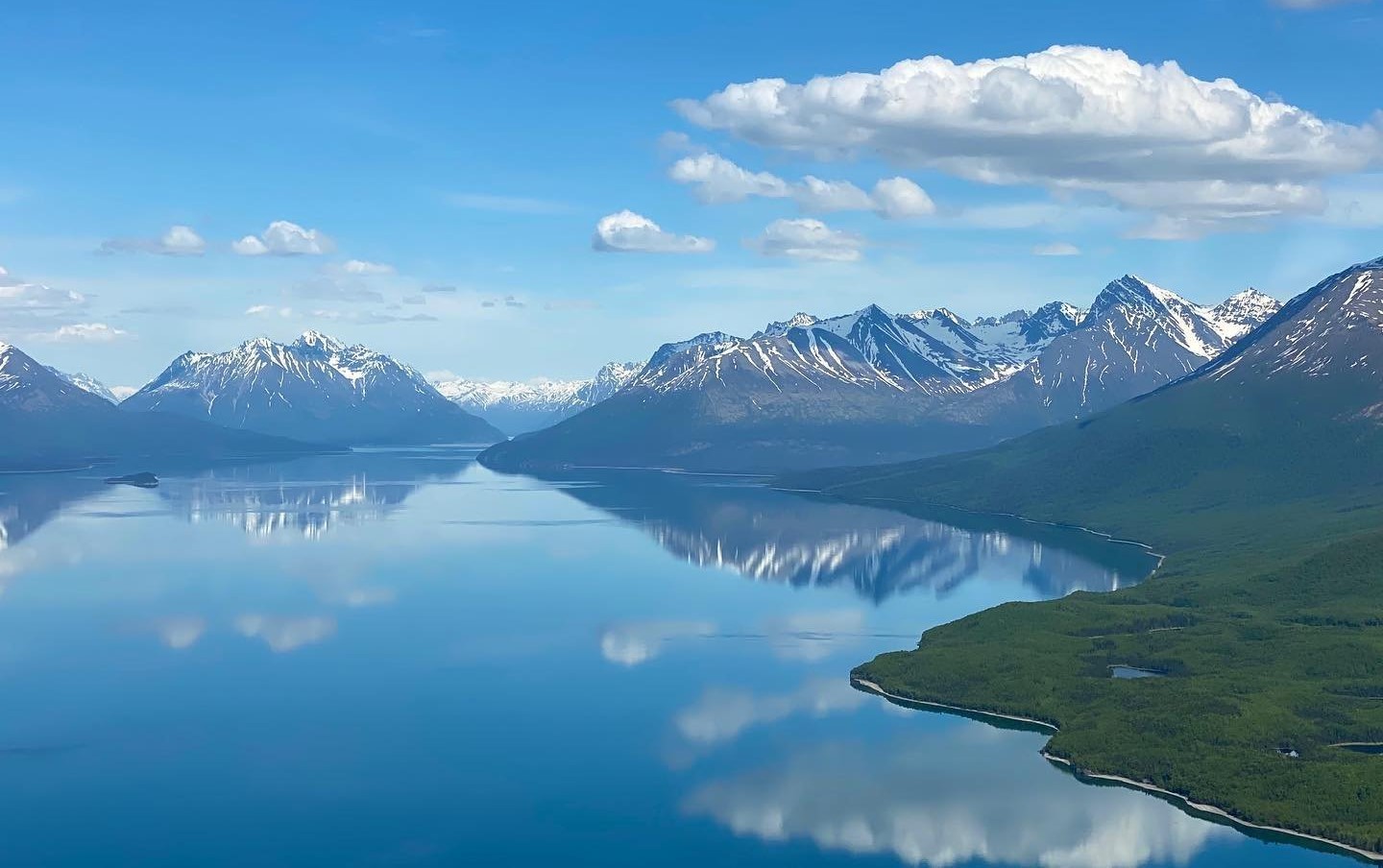
Location: Iliamna Lake is located in the southwestern part of Alaska, near the town of Iliamna. The lake is surrounded by the Chigmit Mountains, which provide a stunning backdrop for this natural wonder.
Surface Area: With a surface area of 1,150 square miles (2,980 square kilometers), Iliamna Lake is one of the largest freshwater lakes in North America. It is approximately 77 miles (124 kilometers) long and 22 miles (35 kilometers) wide, making it a vast and impressive body of water.
Maximum Depth: Iliamna Lake has a maximum depth of 988 feet (301 meters), which makes it one of the deepest lakes in North America. The lake’s depth is one of the reasons why it is so clear and pristine, as it prevents the buildup of sediment and pollutants.
Volume: With a volume of 77.8 cubic miles (325.6 cubic kilometers), Iliamna Lake is a massive body of water. Its sheer size and depth make it an important resource for the local ecosystem and provide vital habitat for a variety of aquatic species.
Interesting Facts about Iliamna Lake
Iliamna Lake is home to several species of fish, including sockeye salmon, lake trout, and Arctic char, making it a popular destination for anglers.
The lake is surrounded by several active volcanoes, including Mount Iliamna, which is the tallest peak in the area and rises to a height of 10,016 feet (3,053 meters).
The lake is also home to several species of wildlife, including brown bears, bald eagles, and moose.
The lake is an important part of the local culture and has been used for thousands of years by the native Aleut people for fishing, hunting, and transportation.
Stories about Iliamna Lake
There are many stories and legends surrounding Iliamna Lake. One such story tells of a giant fish that lives in the lake and is said to be over 30 feet (9 meters) long. According to local folklore, the fish can swallow a man whole and has been known to attack boats. While there is no concrete evidence to support the existence of such a creature, the story continues to capture the imagination of locals and visitors alike.
Industries on Iliamna Lake
Iliamna Lake is a large freshwater lake located in the southwestern part of Alaska, United States. The region surrounding the lake is remote and sparsely populated, and there are relatively few industries in the area. However, some of the industries that do exist include:
Fishing: Iliamna Lake is home to a variety of fish species, including salmon, trout, and char. The fishing industry in the region is an important source of employment and revenue, and there are several fishing lodges and guide services operating in the area.
Tourism: Iliamna Lake and the surrounding area are popular destinations for tourists, who come to enjoy the lake’s natural beauty, fishing, hunting, and outdoor recreational opportunities. The tourism industry is an important source of revenue for the region.
Mining: There are several mining operations in the region surrounding Iliamna Lake, primarily focused on the extraction of copper, gold, and other minerals. Mining is an important industry in the area, providing employment and revenue.
Transportation: Iliamna Lake is an important transportation hub in the region, with several airports and small harbors providing access to remote communities and wilderness areas.
Traditional Indigenous Industries: The region surrounding Iliamna Lake is home to several Alaska Native communities, who continue to engage in traditional industries such as subsistence fishing, hunting, and gathering of wild berries and plants. These industries are an important source of food and cultural heritage for local communities.
History of Iliamna Lake
The history of Iliamna Lake dates back thousands of years to when the native Aleut people first settled in the area. They used the lake for fishing, hunting, and transportation, and their culture is still evident in the area today. In the 1800s, Russian fur traders arrived in the area and established a trading post near the lake. The lake became an important resource for the traders, who used it to transport goods and supplies. In the 1900s, the area around Iliamna Lake became an important hub for gold mining, and the lake was used to transport equipment and supplies to the mines.
Iliamna Lake is a stunning and awe-inspiring natural wonder that has captured the imagination of people for thousands of years. It is #7 on our Top 10 largest lakes. Its size, depth, and crystal-clear waters make it a popular destination for outdoor enthusiasts, scientists, and tourists. The lake is not only a vital resource for the local ecosystem but also an important part of the cultural heritage of the area. From the native Aleut people to the Russian fur traders and gold miners, Iliamna Lake has played a significant role in the history of Alaska. Whether you are a nature lover, a history buff, or an adventure seeker, Iliamna Lake has something to offer. It is a place of natural beauty, cultural significance, and endless possibilities. So, pack your bags and head out to explore the wonder that is Iliamna Lake.
#8: Lake Okeechobee (730 square miles)
Lake Okeechobee is a magnificent body of water located in Florida, USA. It is the second-largest freshwater lake in the contiguous United States, and it has become a popular destination for both tourists and locals alike. With its abundant wildlife, picturesque views, and rich history, Lake Okeechobee offers visitors an exciting and engaging experience.
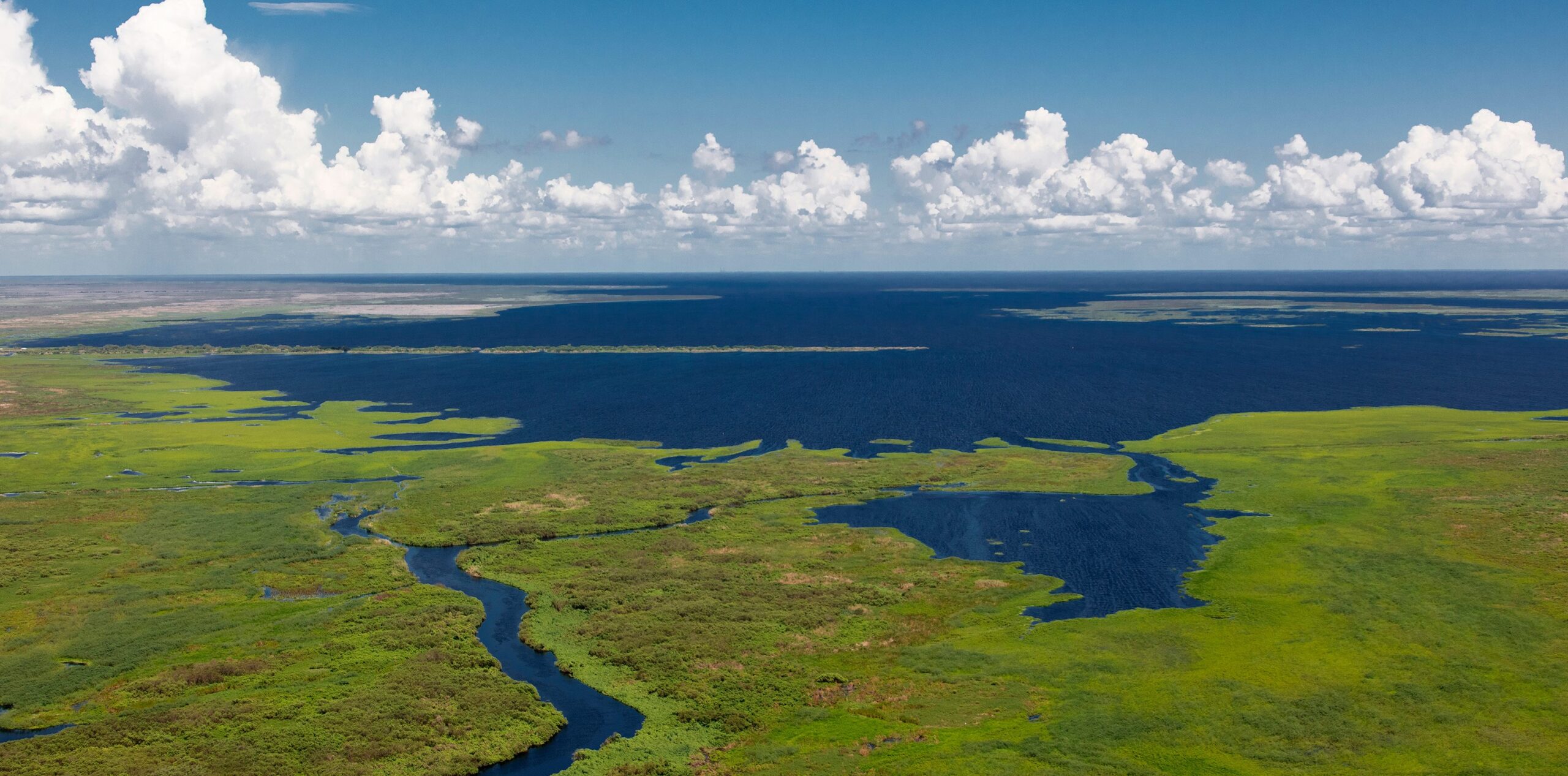
Location: Lake Okeechobee is situated in southern Florida and is the largest lake in the state. The lake is part of the Everglades system and is connected to the Atlantic Ocean via the Caloosahatchee River and the Gulf of Mexico through the St. Lucie River.
Surface Area: Lake Okeechobee has a surface area of 730 square miles (1,890 square kilometers), making it the second-largest freshwater lake in the contiguous United States. It is approximately 35 miles (56 kilometers) long and 30 miles (48 kilometers) wide, and its maximum depth is approximately 12 feet (3.7 meters).
Maximum Depth: The maximum depth of Lake Okeechobee is approximately 12 feet (3.7 meters). This relatively shallow depth makes the lake an ideal habitat for various species of fish and other aquatic wildlife.
Volume: The volume of Lake Okeechobee is approximately 1.4 cubic miles (5.9 cubic kilometers). This vast volume of water is essential for the surrounding ecosystem, providing a habitat for a diverse range of plants and animals.
Interesting Facts about Lake Okeechobee
Lake Okeechobee is the second-largest freshwater lake in the contiguous United States after Lake Michigan.
The lake’s name is derived from the Seminole language and means “big water.”
The Herbert Hoover Dike surrounds Lake Okeechobee, which is approximately 143 miles (230 kilometers) long and was built in the 1930s to prevent flooding.
Lake Okeechobee is home to various species of fish, including largemouth bass, crappie, and bluegill.
The lake is a popular spot for recreational activities, such as fishing, boating, and birdwatching.
Stories about Lake Okeechobee
One of the most notable anecdotes about Lake Okeechobee is the story of the “Okeechobee Hurricane.” In 1928, a massive hurricane struck the region, causing the lake to overflow and resulting in a devastating flood. The disaster claimed over 2,500 lives and remains one of the deadliest natural disasters in US history.
Industries on Lake Okeechobee
Lake Okeechobee is a large freshwater lake located in southern Florida, United States. The region surrounding the lake is primarily agricultural and has a diverse range of industries. Some of the industries that exist around Lake Okeechobee include:
Agriculture: The region surrounding Lake Okeechobee is home to a significant amount of farmland, producing crops such as sugarcane, citrus, and vegetables. The agricultural industry is a major source of employment and revenue in the area.
Fishing: Lake Okeechobee is a popular destination for anglers, and the fishing industry in the region is an important source of employment and revenue. Fish species such as bass, crappie, and bluegill are commonly caught in the lake.
Tourism: Lake Okeechobee and the surrounding area are popular destinations for tourists, who come to enjoy the lake’s natural beauty, recreational opportunities, and cultural attractions. The tourism industry is an important source of revenue for the region.
Water management: Lake Okeechobee is an important part of the regional water management system, and there are several industries focused on managing and maintaining the lake and the surrounding wetlands. These industries include water treatment plants, flood control systems, and environmental consulting firms.
Energy production: There are several power plants in the region surrounding Lake Okeechobee that use biomass, such as sugarcane waste, as a fuel source. These plants provide electricity to the local grid and are an important source of employment and revenue.
Wildlife management: The region surrounding Lake Okeechobee is home to a variety of wildlife, including alligators, waterfowl, and wading birds. There are several industries focused on managing and conserving these species, including wildlife management companies, conservation organizations, and government agencies.
History of Lake Okeechobee
Lake Okeechobee has a rich and storied history, dating back thousands of years. The lake was a vital resource for the indigenous Calusa and Seminole tribes, who relied on its abundant fish and wildlife for sustenance. In the early 20th century, the lake was transformed by the construction of the Herbert Hoover Dike, which significantly altered the surrounding ecosystem. Today, Lake Okeechobee remains a critical resource for the region, providing water for irrigation, wildlife habitat, and recreational activities.
In conclusion, Lake Okeechobee is a remarkable body of water with a fascinating history and abundant wildlife. It is #8 on our Top 10 largest lakes. Whether you’re a local or a tourist, the lake offers a unique and exciting experience that is sure to leave a lasting impression. With its stunning views, rich culture, and diverse ecosystem, Lake Okeechobee is a must-visit destination for anyone seeking adventure and exploration in the heart of Florida.
#9: Lake Pontchartrain (630 square miles)
Nestled in southeastern Louisiana, Lake Pontchartrain is a vast and picturesque lake that holds a special place in the hearts of locals and visitors alike. This iconic body of water has a rich history, unique features, and interesting facts that make it a must-visit destination for anyone exploring the Gulf Coast.
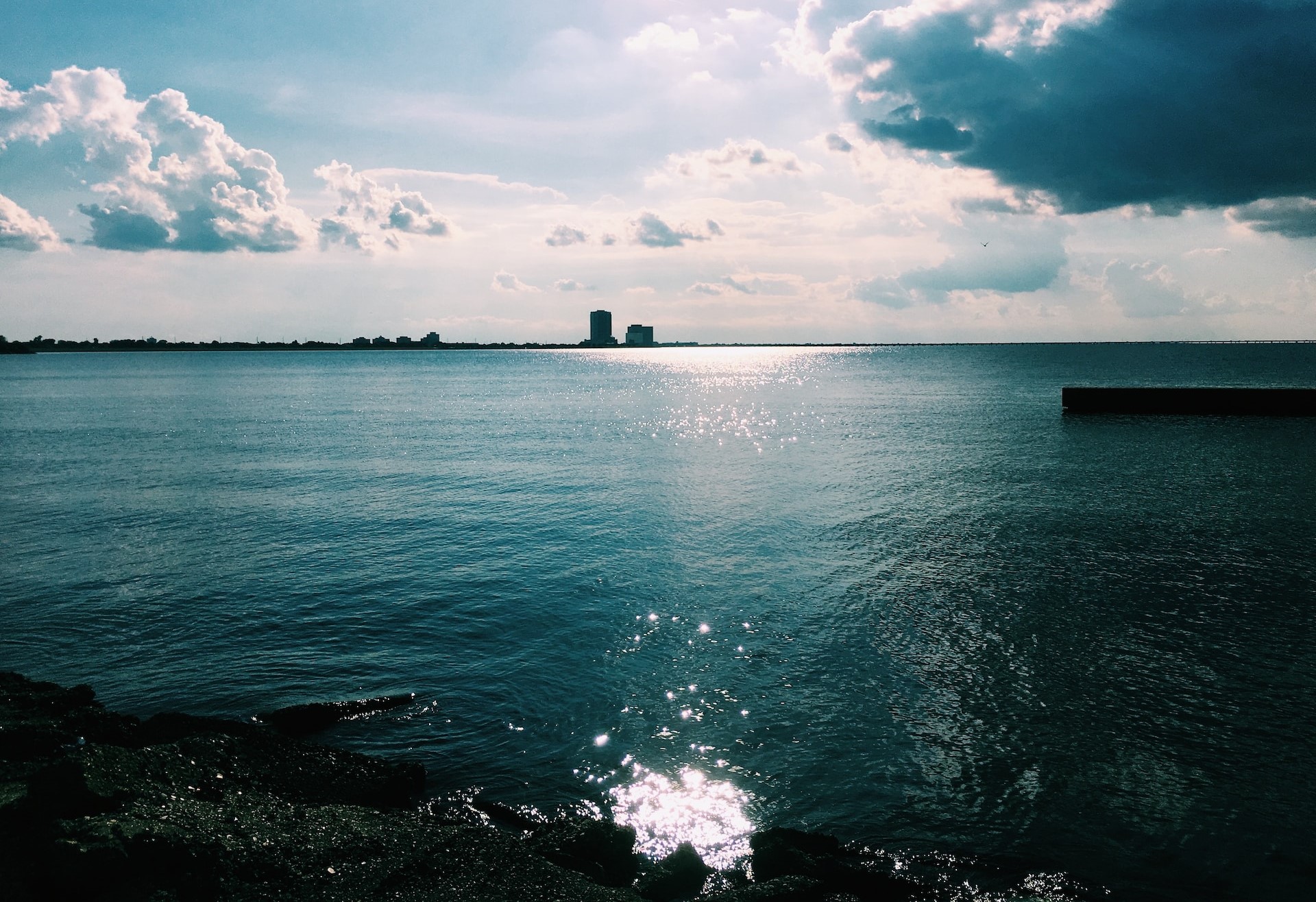
Location: Lake Pontchartrain is located in southeastern Louisiana and is bordered by the cities of New Orleans, Mandeville, and Slidell.
Surface Area: As mentioned earlier, Lake Pontchartrain covers approximately 630 square miles (1,630 square kilometers) of surface area. This expansive body of water is roughly 40 miles (64 kilometers) wide and 24 miles (39 kilometers) long.
Maximum Depth: The maximum depth of Lake Pontchartrain is approximately 80 feet (24 meters). This depth can vary in certain areas, with some parts of the lake being as shallow as 5 feet (1.5 meters).
Volume: Lake Pontchartrain has a total volume of approximately 12 cubic miles (50 cubic kilometers) of water. This vast volume of water is home to a diverse array of fish, birds, and other aquatic life.
Interesting Facts about Lake Pontchartrain
One interesting fact about Lake Pontchartrain is that it is actually an estuary, meaning that it is a partially enclosed body of water where freshwater from rivers and streams meets the saltwater from the Gulf of Mexico. Additionally, the lake is home to a unique species of fish called the Lake Pontchartrain Basin speckled trout, which is only found in this particular body of water.
Stories about Lake Pontchartrain
Many people have fond memories of Lake Pontchartrain, with some even claiming that it has a mystical quality that draws them back time and time again. For example, some locals believe that the lake has its own Loch Ness monster-type creature that they call the “Pontchartrain Paddler.” hile there is no scientific evidence to support this claim, it adds to the lake’s charm and mystique.
Industries on Lake Pontchartrain
Lake Pontchartrain is a large brackish lake located in southeastern Louisiana, United States. The region surrounding the lake has a diverse range of industries, including:
Fishing: Lake Pontchartrain is home to a variety of fish species, including redfish, speckled trout, and flounder. The fishing industry in the region is an important source of employment and revenue.
Shipping and transportation: Lake Pontchartrain is an important transportation hub in the region, with several ports and marinas providing access to the Gulf of Mexico and the Mississippi River. The shipping industry is an important source of employment and revenue.
Oil and gas production: There are several oil and gas production platforms located in Lake Pontchartrain and the surrounding area, providing a significant source of employment and revenue.
Tourism: Lake Pontchartrain and the surrounding area are popular destinations for tourists, who come to enjoy the lake’s natural beauty, recreational opportunities, and cultural attractions. The tourism industry is an important source of revenue for the region.
Environmental consulting and remediation: Due to the impact of Hurricane Katrina and other environmental concerns, there are several industries focused on environmental consulting and remediation in the region. These industries provide services such as site assessment, remediation, and environmental compliance monitoring.
Manufacturing: There are several manufacturing facilities in the region surrounding Lake Pontchartrain, producing products such as chemicals, plastics, and building materials. The manufacturing industry is an important source of employment and revenue.
History of Lake Pontchartrain
Lake Pontchartrain has a long and storied history that dates back centuries. The lake was named after Louis Phélypeaux, comte de Pontchartrain, who served as the French Minister of the Marine under King Louis XIV. Throughout history, the lake has served as an important transportation hub for goods and people, as well as a source of food and recreation for locals.
In conclusion, Lake Pontchartrain is a truly unique and fascinating body of water that has played an important role in the history and culture of southeastern Louisiana. It is #9 on our Top 10 largest lakes. From its interesting facts and anecdotal stories to its vast size and diverse aquatic life, there is no shortage of reasons to explore and appreciate this iconic lake. Whether you’re a local or a visitor, a trip to Lake Pontchartrain is sure to be a memorable and enjoyable experience.
#10: Red Lake (482 square miles)
Red Lake is a majestic body of water located in northern Minnesota, United States. Known for its stunning natural beauty and rich history, this lake has been a popular destination for tourists and locals alike for many years. From its vast surface area to its maximum depth, Red Lake offers a range of interesting features that make it an exciting place to explore.
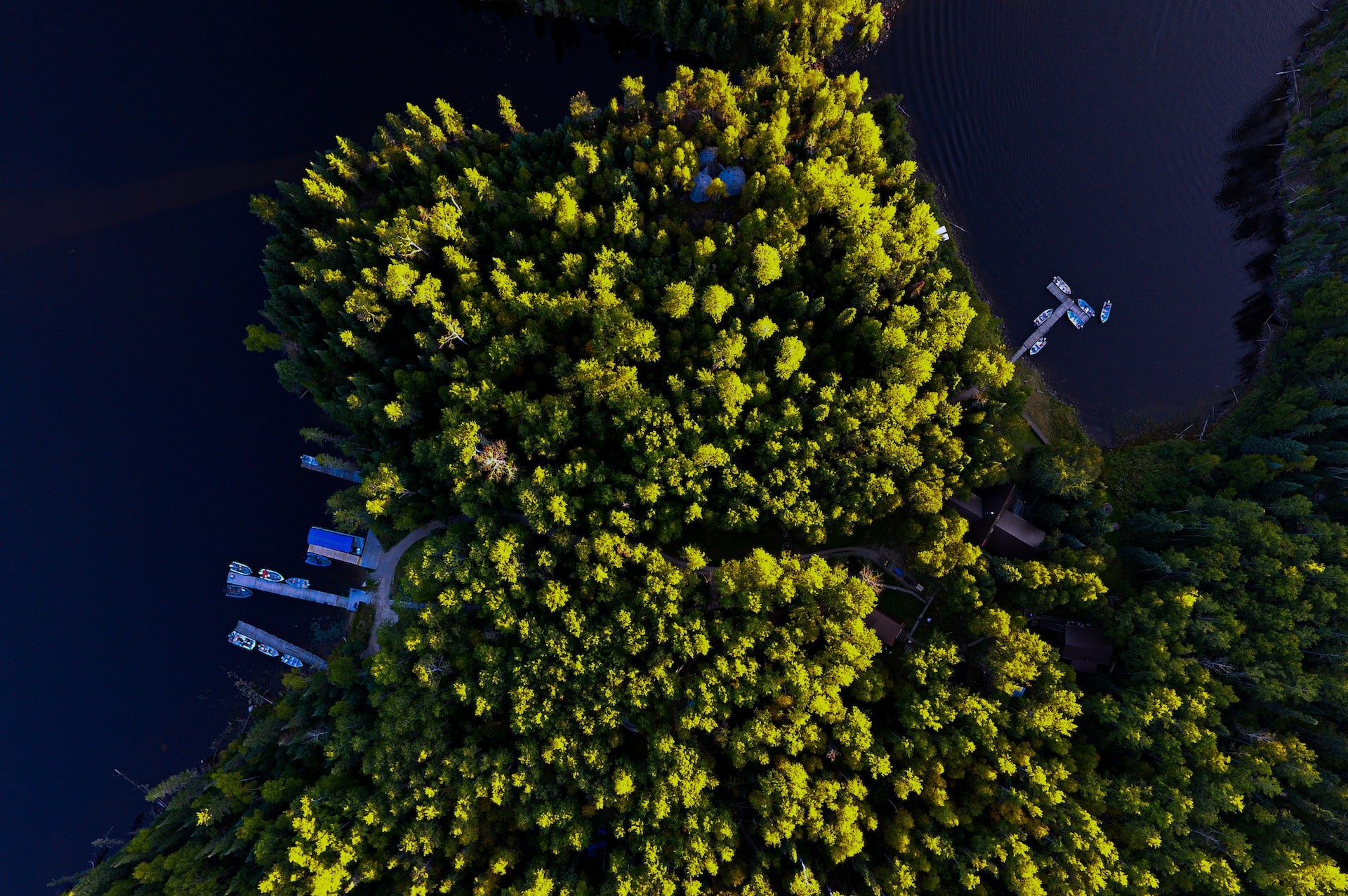
Location: Red Lake is located in northern Minnesota, approximately 240 miles north of Minneapolis. The lake is situated within the Red Lake Indian Reservation, which is home to the Red Lake Band of Chippewa Indians.
Surface Area: Red Lake is one of the largest lakes in Minnesota, with a surface area of approximately 1,256 square miles (3,254 square kilometers). This makes it the second-largest lake entirely within the state, after Mille Lacs Lake.
Maximum Depth: The maximum depth of Red Lake is approximately 119 feet (36 meters). While not the deepest lake in Minnesota, it is still a significant depth that offers a unique and challenging environment for those looking to explore its waters.
Volume: The volume of Red Lake is estimated to be around 6.3 cubic miles (26 cubic kilometers). This massive amount of water makes Red Lake a critical resource for the surrounding communities and an important source of freshwater for the region.
Interesting Facts About Red Lake
Red Lake is not only a beautiful natural wonder but also a place full of fascinating facts and history. Here are a few of the most interesting things about this unique lake:
Red Lake is one of the only two naturally occurring freshwater lakes in the world that is not connected to any other body of water.
The name “Red Lake” comes from the reddish color of the water caused by the abundance of iron in the lake’s sediment.
The lake is home to a variety of fish species, including walleye, northern pike, and yellow perch.
The Red Lake Indian Reservation is home to the largest Chippewa Indian tribe in the United States, and the tribe has a deep connection to the lake.
Red Lake is a popular destination for outdoor enthusiasts and offers a range of recreational activities, including fishing, boating, and hiking.
Stories About Red Lake
Red Lake has a rich history that includes many interesting anecdotes and stories. Here are a few examples:
The Red Lake Band of Chippewa Indians has a longstanding tradition of netting fish in the lake, which has been passed down for generations. The annual Red Lake Walleye Tournament attracts anglers from all over the country, and the fish caught during the tournament are often sold to local restaurants and markets.
The lake has been the site of many tragic events over the years, including the infamous 2005 Red Lake High School shooting, which claimed the lives of ten people, including the shooter.
According to legend, there is a massive fish that lives in the depths of Red Lake, known as the “Old Timer.” While there is no evidence to support the existence of such a creature, the story persists and adds to the mystique of the lake.
Industries on Red Lake
Red Lake is a large freshwater lake located in northern Minnesota, United States. The region surrounding the lake has a diverse range of industries, including:
Fishing: Red Lake is home to several fish species, including walleye, northern pike, and yellow perch. The fishing industry in the region is an important source of employment and revenue.
Forestry: The region surrounding Red Lake has large areas of forested land, and the forestry industry is an important source of employment and revenue. Products such as paper, lumber, and wood pellets are produced in the region.
Mining: There are several mining operations in the region surrounding Red Lake, producing metals such as gold and copper. The mining industry is an important source of employment and revenue.
Tourism: Red Lake and the surrounding area are popular destinations for tourists, who come to enjoy the lake’s natural beauty, recreational opportunities, and cultural attractions. The tourism industry is an important source of revenue for the region.
Agriculture: The region surrounding Red Lake has a significant amount of farmland, producing crops such as soybeans, corn, and wheat. The agricultural industry is a source of employment and revenue in the region.
Manufacturing: There are several manufacturing facilities in the region surrounding Red Lake, producing products such as machinery, electronic components, and food products. The manufacturing industry is an important source of employment and revenue.
History of Red Lake
Red Lake has a rich history that dates back thousands of years. The lake was originally formed by glaciers during the last ice age, and evidence of early human settlements has been found along its shores. The lake has been an important resource for the Red Lake Band of Chippewa Indians for centuries, and the tribe has a deep spiritual connection to the water. Over the years, the lake has been the site of many important events, including the signing of the Treaty of Old Crossing in 1863, which ceded a large portion of land to the United States government.
In the early 20th century, commercial fishing became a major industry on Red Lake, and the lake was known for its abundant walleye and northern pike populations. However, overfishing and environmental degradation caused a decline in fish populations in the mid-20th century, and the commercial fishing industry was eventually shut down in the 1990s to allow the lake’s fish populations to recover.
Today, Red Lake remains an important resource for the Red Lake Band of Chippewa Indians and a popular destination for outdoor enthusiasts. The lake’s rich history and unique ecology continue to attract visitors from around the world.
In conclusion, Red Lake is a fascinating and beautiful natural wonder that offers a range of unique features and experiences. It is #10 on our Top 10 largest lakes. From its vast surface area to its maximum depth and rich history, Red Lake is a place that has captured the imaginations of people for generations. Whether you are interested in fishing, hiking, or simply enjoying the beauty of nature, Red Lake is a destination that is well worth a visit.
Our Top 10 lakes in the United States highlights some of the most beautiful and diverse natural wonders in the world. From the Great Lakes to the salt flats of Great Salt Lake, each lake on this list has its own unique features and attractions that draw visitors from around the world. Whether you’re looking for a peaceful getaway or an action-packed adventure, the lakes of the United States offer something for everyone. So pack your bags, grab your fishing rod or hiking boots, and get ready to explore the majestic lakes of the United States.
Lakes and Maps
Lakes and maps have an intricate and mesmerizing relationship. Maps are often the gateway to discovering the secrets and wonders hidden within a lake’s depths. A map can reveal the twists and turns of a lake’s shoreline, its depths, and its hidden coves. It can show the location of a lake in relation to the surrounding area, marking the mountains, rivers, and towns that frame it. The colors on a map can hint at the clarity of the water, the vegetation surrounding the lake, and the terrain beneath the surface. A map can also be a reflection of a lake’s history, marking the locations of important battles, settlements, and landmarks.
Lakes and maps are like two sides of a coin, each one revealing a different aspect of the same object. Maps give us a way to understand and navigate the physical world around us, while lakes remind us of the beauty and mystery that lies within it. Together, they invite us to explore, discover, and connect with the natural world in ways that are both tangible and transcendent. Whether we’re gazing at a map or standing at the edge of a lake, we are reminded that the world is a vast and wondrous place, full of mysteries and wonders waiting to be explored.
Learn more about Maps
- Topographical Maps: Representation of the physical features of a region or area.
- Contour Maps: Representation of the contours of the land surface or ocean floor.
- Raised Relief Maps: Representation of land elevations with raised features indicating landforms.
- Terrain Maps: Representation of the physical features of a terrain or landmass.
- USGS Topographic Maps: Representation of topographic features and land elevations based on USGS data.
- USGS Historical Topographic Maps: Representation of historical topographic maps created by the USGS.
- Watershed Maps: Representation of the areas where water flows into a particular river or lake.
- Elevation Maps: Representation of land and water elevations with high precision.
- Physical Maps: Representation of physical features of the Earth’s surface such as landforms, oceans, and plateaus.
- Bathymetric Maps: Representation of the topography and features of the ocean floor.
- NOAA Maps: Representation of atmospheric, oceanographic, and environmental data by NOAA.
- Nautical Maps: Representation of the underwater features and depth of an area for navigation purposes.
- Geologic Maps: Representation of the geologic features of an area such as rock types, faults, and folds.
- Satellite Maps: Representation of earth from high-definition satellite imagery.
Contact us today to learn more about our services and how we can help you achieve your goals.
